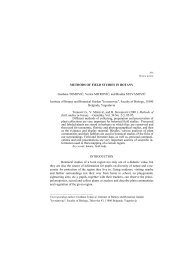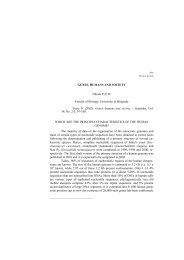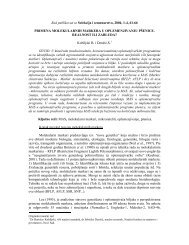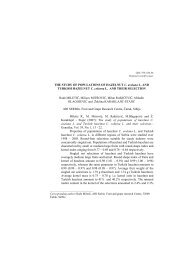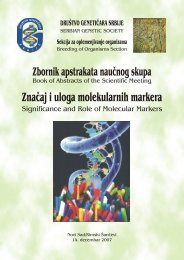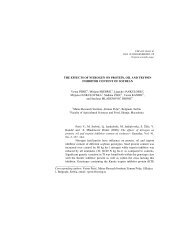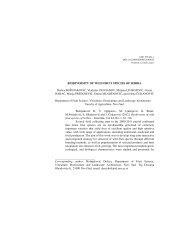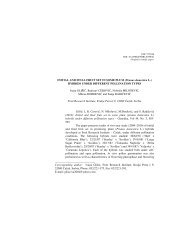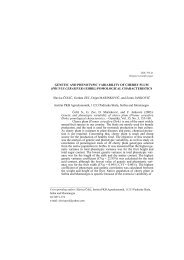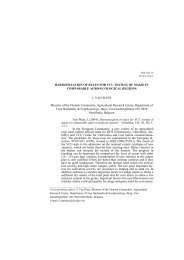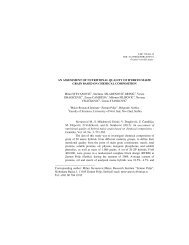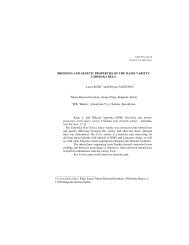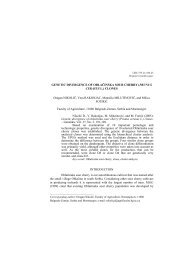Zbornik - Društvo genetičara Srbije
Zbornik - Društvo genetičara Srbije
Zbornik - Društvo genetičara Srbije
Create successful ePaper yourself
Turn your PDF publications into a flip-book with our unique Google optimized e-Paper software.
204 ZBORNIK ABSTRAKATA III KONGRESA GENETIÈARA SRBIJE V-Pos-1<br />
Subotica, 30. novembar - 4. decembar 2004.<br />
HETEROGENE ABERACIJE 11q23 U HEMATOLOŠKIM MALIGNITETIMA<br />
Sandra Biiæ, Vesna Ðorðeviæ, Marija Denèiæ-Fekete, Jelica Jovanoviæ,<br />
Mirjana Gotiæ i Darinka Boškoviæ<br />
Institut za hematologiju, Klinièki centar <strong>Srbije</strong>, Beograd<br />
Aberacije na hromozomu 11 u regionu q23 mogu se uoèuiti citogenetskom analizom u<br />
svim hematološkim malignitetima sa uèestalošæu do 10% kao solo aberacija ili udruene<br />
sa drugim hromozomskim promenama. U regionu 11q23 mapiran je MLL gen, èiji je<br />
produkt vaan regulacioni faktor procesa hematopoeze, tako da sve promene u ovom<br />
regionu dovode do maligne transformacije æelija razlièitih krvnih loza. Zbog èinjenice da<br />
su aberacije u ovom regionu hromozoma 11(11q23/MLL) veoma razlièite i nisu u<br />
korelaciji sa morfologijom trasformisanih æelija, klasifikovane su kao poseban entitet<br />
malignih hemopatija (WHO classification). Posebno su interesantne translokacije koje<br />
dovode do fuzije MLL gena sa oko 50 razlièitih «partner» gena. Bolesnici kod kojih je<br />
utvrðeno prisustvo aberacije 11q23/MLL imaju lošu prognozu bez obzira na tip promene.<br />
Kod 11 bolesnika promena u regionu 11q23 je bila kao solo aberacija, a kod 9 bolesnika<br />
udruena sa drugim aberacijama. Promene 11q23 su bile tipa: delecija, inverzija , adicija<br />
hromatinskog materijala nepoznatog porekla i translokacija. Najèešæa translokacija bila<br />
je sa partner genom na hromozomu 4(q21) kod 7 bolesnika, po jednog bolesnika sa<br />
genom na hromozomu 2(p21), na hromozomu 17(q12) i na hromozomu 19(p13).<br />
Posebno je interesantna kompleksna translokacija u kojoj pored hromozoma 11 uèestvuju<br />
hromozomi 7(q22) i 12(p13).<br />
Aberacije 11q23 u grupi naših bolesnika bile su heterogene po tipu promena, vrsti «partner»<br />
gena ukljuèenih u fuziju, što nije imalo znaèaja za dalji tok bolesti kao ni odgovor na<br />
terapiju.<br />
HETEROGENOUS ABNORMALITIES OF 11q23<br />
AT HEMATOLOGICAL MALIGNANTS<br />
Chromosome 11 abnormalities at q23 region can be observed by conventional<br />
cytogenetic analyses at all hematological malignants with frequence up to 10%, as solo<br />
abnormality or in combination with other chromosomal abnormalities. Product of MLL<br />
gene, which is maped at 11q23 region, is important hematopoesis regulation factor.<br />
Therefore, all abnormalities at this region lead to malignant blood cell transformations.<br />
As abnormalities at this region of chromosome 11 (11q23/MLL) are heterogeneous and<br />
they are not in correlation with morphology of transformed cells, this aberations were<br />
classified as a separate group of malignant hemopathy (WHO classification).<br />
Translocations, which lead to fussion of MLL gene with about 50 different «partner»<br />
genes, are especially interesting. Patients with 11q23/MLL abnormality have poor prognosis<br />
for all types of abnormalities.<br />
It was obsereved that in 11 patients abnormalities at 11q23 region occured as a solo abnormalities,<br />
but in 9 patients this anormality was associated with other abnormalities.<br />
Types of 11q23 abnormalities were: deletions, inversions, aditions of chromatine material<br />
of unknown source and translocations. The most abundant translocation was with the<br />
partner gene at chromosome 4(q21) – 7 patients. Other translocations were with partner<br />
gene: at chromosome 2(p21) – 1 patient, at chromosome 17(q12) – 1 patient and at chromosome<br />
19(p13) – 1 patient. A complex translocation of chromosome 11 with chromosome<br />
7(q22) and chromosome 12(p13) was especially interesting.<br />
11q23 aberations, in our group of patients, were heterogenous by type of aberation, kind<br />
of partner genes included in fussion, but without importance for the course of a disease<br />
and outcome to therapy.



